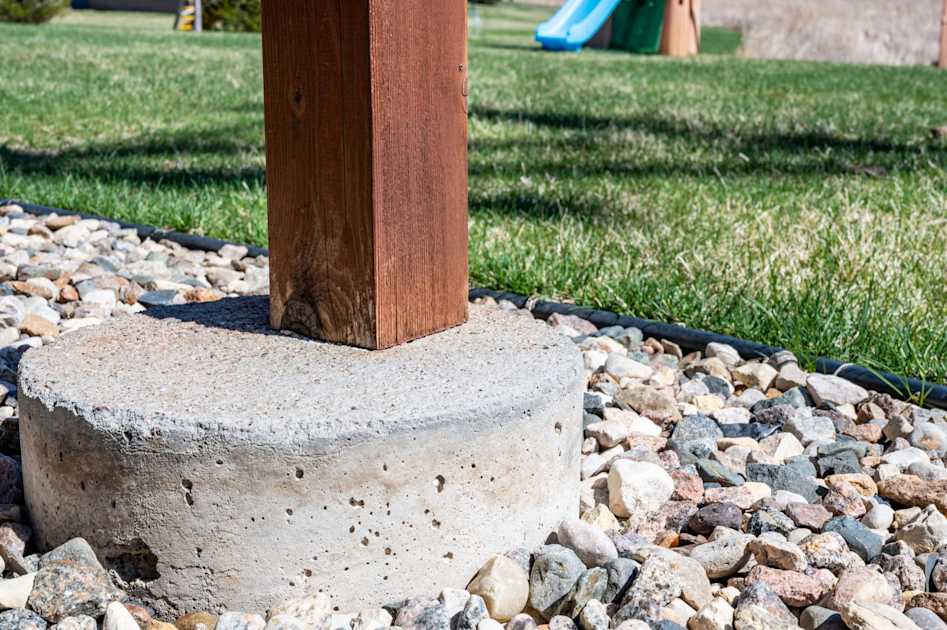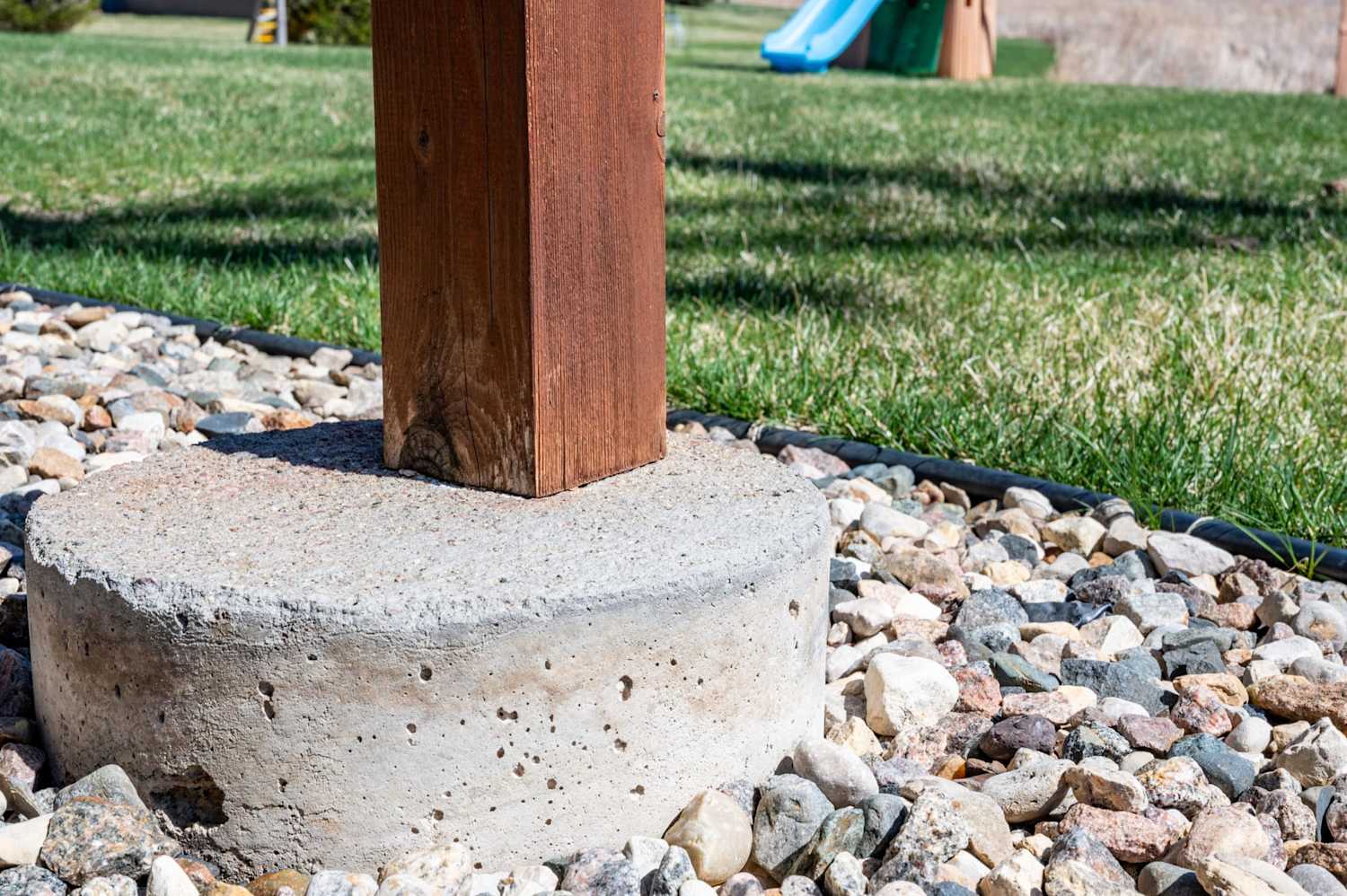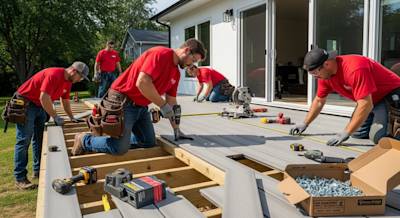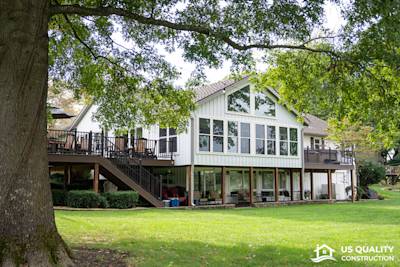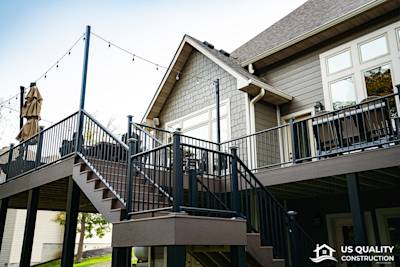Building your dream deck might seem like a daunting task but understanding and executing the crucial construction elements correctly is key. One of these essential elements includes the installation of deck footings. Deck footings provide the solid foundation that holds your deck in place, making it sturdy and reliable. So, figuring out how to create your deck’s foundational groundwork is an absolute must. That’s why in this blog, we will explore everything you need to know about deck footings including types, installation tips, and the importance of correct installation. Let’s jump in!
An Overview of Deck Footings
Deck footings are crucial elements in deck construction. They serve as the base that supports the deck's underlying structure ensuring its stability and safety. Basically, deck footings are designed to bear the load of the deck and distribute this weight evenly to the ground. It is important to size and position them correctly to prevent undue stress points or sagging in the deck’s structure. Installation of deck footings involves digging holes in the ground, pouring concrete, and then placing a post bracket on top once the concrete has solidified.
Types of Deck Footings
There are various types of deck footings available, each designed to suit different types of terrain, deck designs, and soil conditions.
-
Concrete Piers: These are the most common type of deck footings. Concrete is poured directly into a hole in the ground and an anchor is embedded within the concrete to hold the deck post.
-
Concrete Blocks: Seldom used nowadays, concrete blocks or deck blocks rest on top of the ground and can be a quicker, easier solution, especially for smaller, lighter decks.
-
Screw Piles: A popular choice for their strength and ease of installation, screw piles are twisted into the ground using machinery, providing a strong, secure footing. They are ideal for dealing with soft ground and high water tables.
Importance of Correct Deck Footing Installation
If you're wondering why putting emphasis on correctly installing deck footings is so important, here's why:
-
Safety: Deck footings are critical for the stability of the deck and hence everyone who uses it. Poorly installed footings could collapse causing injury.
-
Longevity: A well-installed deck footing helps increase the life span of your deck by providing a solid, stable base.
-
Legal requirements: Most areas have strict building codes and regulations for deck construction. Incorrectly installed footings may result in violation of these codes.
Installation Tips for Deck Footings
Correct installation of deck footings is a cornerstone for a sturdy and safe deck. Follow these tips:
-
Plan Ahead: You need to consider the location, size, and type of your deck, plus the type of soil in your yard. Each of these factors influences the type and size of the footings you'll need.
-
Follow Building Code: Ensure you adhere to local building codes. These can dictate depth, diameter, and other specifications for footings.
-
Hire a Professional: If you're a novice DIYer, it's suggested to hire a professional to avoid costly or dangerous mistakes.
Deck Footing Depth and Diameter
The depth and diameter of your deck footings are determined by a few factors, including the deck size, load it will bear, type of soil, and the local frost line. Generally, the depth of the footing must extend beyond the frost line to prevent shifting during freeze and thaw cycles.
Deck Footing Spacing
The empty space between footings is determined by the size of your deck and the weight it will carry. This spacing is crucial to the stability of the entire deck.
Understanding the functionality, types, importance, and correct installation of deck footings will ensure your deck remains secure and lasts for years. While you can often install deck footings yourself, consider hiring skilled contractors to ensure your deck is safe, sturdy, and abides by all local building codes. Happy Deck Building!
Frequently Asked Questions about Deck Footings
What is the purpose of deck footings?
Deck footings are an extremely crucial aspect of your deck's construction. They provide support and stability, serving as the foundation of your deck. By transferring the heavy load of your deck to the ground, they prevent the deck from sinking or shifting – issues that could cause damage or misalignment. They also prevent frost heave issues in cooler climates.
What are the different types of deck footings?
Deck footings come in several types, each suitable for different deck configurations and soil conditions. The most common types include concrete footings, which are poured into dug holes; precast piers, which are bought already cast and simply placed and backfilled; and helical piers, which are screwed into the ground for extra stability in certain conditions.
How deep should deck footings be?
The depth of your deck footings depends on the local building codes, frost line depths, and soil conditions. In general, they should be at least as deep as the frost line to prevent heaving, and must typically extend below the topsoil into the more stable subsoil. This often means a depth of at least 36 inches, but specific regulations can vary by location.
Are there any regulation size for deck footings?
Yes, the size and depth of deck footings are governed by local building codes, which are based on factors like soil type and loads. The size of the footing determines the load it can bear, so it must be properly sized to support your deck. Consulting a professional or local building inspector can provide exact specifications for your area and deck design.
Can you use deck blocks as footings?
Deck blocks can be used as footings in some circumstances, but they don't offer the same load-bearing capabilities or stability as traditional concrete footings. They're typically used for smaller, lighter constructions like free-standing decks and sheds. You should check with your local building code to see if deck blocks are permitted for your planned construction.
Can deck footings be adjusted?
Once deck footings are installed, adjusting them can be quite difficult. It's vital to get the placement and depth correct during installation to avoid later adjustments. If adjustments are absolutely necessary, it can involve jacking up the deck, excavating around the footing, moving or adjusting the footing, and then backfilling. Consult a professional if you find yourself in this situation.
How long does it take for deck footings to dry?
Concrete deck footings usually take about 24 to 48 hours to dry enough to be able to support some weight. However, full strength and stability is typically not achieved until about 28 days of curing time. Weather conditions, like humidity and temperature, can affect the drying time, so it may be best to budget extra time for this process to avoid any complications.
How far apart should deck footings be?
The spacing of deck footings is determined by the size and weight of the deck, the size and type of the support beams used, and load requirements from your local building code. On average, deck footings should be spaced between 4 to 8 feet apart, but the specific spacing for your deck should be calculated based on these factors.
Can deck footings be reused?
In some cases, if the footings are in good condition and meet current building codes, existing deck footings can be reused for a deck rebuild. However, their condition and suitability should be thoroughly evaluated by a professional before deciding to reuse them. If there is any doubt about their integrity, it's best to install new footings to ensure the stability and safety of your deck.
How to prevent frost heave for deck footings?
To prevent frost heave, your deck footings should be installed below your area's frost line depth. Similarly, using footings like helical piers, which can be installed deeper into the ground, can also provide additional prevention against frost heave. Ideally, you should consult with a local professional to make sure your deck footings are adequate to withstand frost heave.
Pros and Cons of Deck Footings
A Detailed Look at the Pros of Deck Footings
Durability
One of the primary advantages of deck footings is their durability. Because these structures are generally made of concrete, deck footings are frequently resistant to decay, weathering, and other forms of deterioration. This can help to ensure a long lifespan for your deck, potentially saving you money on replacement and repair costs over time.
Stability and Support
-
Provides Excellent Support: Deck footings stabilize your deck by bearing its weight and preventing it from sinking into the ground. They ensure that the deck remains level, providing a secure platform for outdoor activities.
-
Prevents Deck Movement: Deck footings act as an anchor for your deck, preventing any lateral movement. This is particularly beneficial in areas susceptible to high winds or seismic activity.
Flexibility in Deck Design
Deck footings also offer a degree of flexibility when it comes to deck design. The footings can accommodate a variety of shapes and sizes, allowing for custom deck configurations. Because deck footings can be positioned with precision, they facilitate the precise alignment and leveling of a deck, regardless of its complexity.
A Detailed Look at the Cons of Deck Footings
Installation Challenges
-
Labor-Intensive: The process of installing deck footings can be labor-intensive. Depending on the size and design of the deck, preparing, digging, pouring, and properly setting the footings may take significant time and effort.
-
Require Professional Expertise: Installation of deck footings often requires professional expertise. Improper installation can lead to instability or unevenness, which may impact the functionality and safety of the deck. Therefore, it's typically not a DIY-friendly project.
Cost
Another potential downside of deck footings is their cost. The initial expense of concrete footings, including both material and labor costs, can be substantial. This, coupled with the ongoing maintenance costs, might make deck footings a costly choice for some homeowners.
Impact on Landscape
Deck footings may also have some negative impact on the landscape. Digging the holes for the footings can disrupt the surrounding grass and plantings, and could lead to potential erosion issues if not properly managed. Moreover, the footings themselves can be unsightly, especially if they are left exposed.
Consideration of Different Deck Footing Types
Concrete Footings
-
Pros: Concrete footings provide excellent support and durability. They can be sized and shaped correctly to adhere to local building codes and can be formed into almost any shape to fit deck designs.
-
Cons: Concrete footings can be labor-intensive to install. They also require time to cure, delaying the decking process. Incorrect pouring or curing can cause these footings to crack or crumble over time.
Pile Footings
-
Pros: Pile footings, often made of steel, provide great stability and can bear a high load. They can be installed more quickly than concrete footings and require less disturbance to the landscape.
-
Cons: Pile footings are generally more expensive than concrete footings and may still require concrete to be poured into or around them to further secure them.
Screw Piles or Helical Piers
-
Pros: Screw piles can be driven deep into the ground, providing an improved level of stability and support. They are easy to install and cause minimal disruption to the landscape.
-
Cons: Screw piles often require professional installation due to the large machines used to screw them into the ground. This can raise the cost, and additionally, they may not be suitable for all soil types.
Summary
To sum up, understanding the importance of deck footings is crucial. They serve as the foundation for your deck, offer stability and ensure it can withstand weight and weather conditions. Proper preparation and installation of deck footings is valuable for any construction project. It's all about giving your deck a solid base!
Your deck's longevity and safety are directly tied to the quality of its deck footings. Getting them right means less worry about repairs or possible collapse. A well-installed deck footings guarantees peace of mind for homeowners, providing a reliable platform for outdoor enjoyment.
Finally, deck footings are a must-have component of any sturdy and durable deck. They ensure that the weight of your deck is evenly distributed and will stand the test of time. So, when building your next deck, put deck footings at the top of your checklist for a long-lasting, firm, and secure installation!
About US Quality Construction
Welcome to US Quality Construction, based right here in the heart of Kansas City, MO. We are more than just a construction company; we are a dedicated team that's committed to providing unparalleled customer service. Known for our exceptional work and detail-oriented projects, we take pride in creating structures that are not just beautiful and innovative, but sustainable and efficient, too. With a portfolio spanning across various construction genres, our passion is reflected in every project we undertake. Our Kansas City roots run deep, so you can trust you’re getting only the best when you work with US Quality Construction.
Tags: Deck Construction, Foundation, Outdoor Living,


